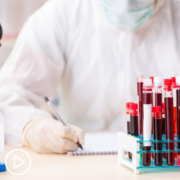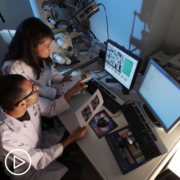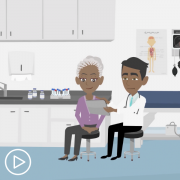What Is the AGILE Study? Research for AML Patients With the IDH1 Mutation
What Is the AGILE Study? Research for AML Patients With the IDH1 Mutation from Patient Empowerment Network on Vimeo.
AML expert Dr. Omer Jamy reviews the results of the AGILE study, a clinical trial evaluating the efficacy and safety of ivosidenib + azacitidine vs placebo + azacitidine in patients with previously untreated AML with an IDH1 mutation.
Dr. Omer Jamy is a Leukemia and Bone Marrow Transplant Physician and Assistant Professor at the University of Alabama at Birmingham. Learn more about Dr. Omer Jamy.
Related Resources:

Advances in the Treatment of Relapsed/Refractory Acute Myeloid Leukemia (AML) |

|

Essential Testing Optimizing AML Care with Personalized Medicine |
Transcript:
Katherine Banwell:
Dr. Jamy, data was presented at ASCO from the agile study. What is the study and what does the news mean for AML patients?
Dr. Omer Jamy:
Yes, thank you. So, the AGILE study is basically a randomized Phase III study. It is specifically for patients with AML who harbor an IDH1 or isocitrate dehydrogenase 1 mutation. Now IDH1 mutation is thought to be rare.
It occurs in around six to 12 percent of patients with acute myeloid leukemia. So, a few years ago there was a drug approved by the FDA to treat patients in the relapsed or refractory setting with an IDH1 mutation. And that drug is called ivosidenib (Tibsovo). And this drug is also approved for elderly patients ineligible for intensive chemotherapy but it was mainly initially approved for the relapsed/refractory setting.
So, all of these drugs when they initially get approved – so this is targeted therapy. It’s targeting IDH1 mutant AMLs, so patients with AML without an IDH mutation will not benefit from such a drug. So, when you find targeted therapy, the general workflow is it gets tested in the later settings. If it looks promising, then people try to bring it in the upfront settings. So, this was a Phase III study of newly diagnosed acute myeloid leukemia patients harboring an IDH mutation.
And it randomized them to a combination of azacitidine plus ivosidenib versus azacitidine plus placebo.
When the study was started, the standard of care for patients ineligible to receive intensive chemotherapy was azacitidine (Vidaza). So, this study again, just to highlight, focused on patients who were not ineligible for intensive chemotherapy. So, these may be patients who were either above the age of 75 or below the age of 75 but had comorbidities which would have prevented them from receiving intensive chemotherapy. These comorbidities could be any organ dysfunction such as the heart, kidneys, liver, lung, or poor performance status. So, the primary endpoint of the study was event free survival. And the primary endpoint of the study was met with a hazard ratio of .33 in favor of the combination of azacitidine and ivosidenib. The study also showed that overall survival was improved in patients getting the combination compared to patients just getting azacitidine and placebo.
Which was roughly around 20 to 24 months versus eight months for the placebo and azacitidine arm. And then obviously when you combine drugs you want to make sure that by adding two drugs, you’re not causing more toxicity. So, the toxicity profile between the two arms was similar actually. They saw less infections and neutropenia in the ivosidenib and azacitidine arm compared to azacitidine alone. So, that was basically the AGILE study where they looked at patients with IDH mutant acute myeloid leukemia.










